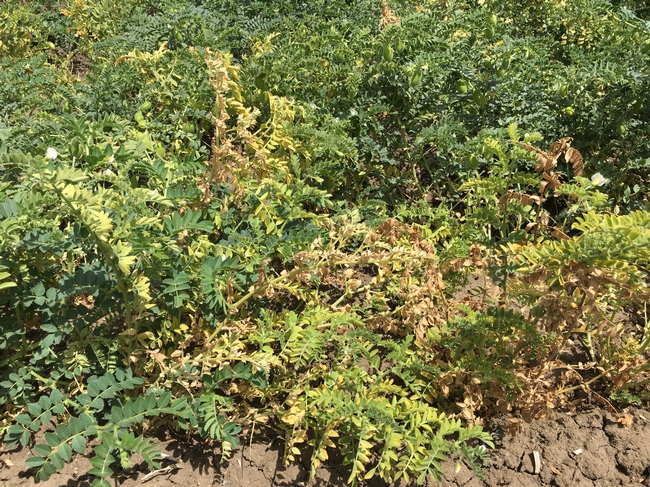
My observations of the field were that there were patches of several nearby plants with symptoms, but across the three contiguous fields, the patches were widespread. I suspected a vascular disease because of what appeared to be a progression of the disease from yellowing to necrosis to eventually plant death. I submitted samples to the plant pathology lab at UC Davis, and they diagnosed Fusarium oxysporum f. sp. ciceris, which is the Fusarium wilt pathogen for garbanzos. Fusarium wilt (also called Fusarium yellows) has the external symptoms previously described, but in addition to these symptoms, splitting the stems may reveal reddish-brown streaking in the vascular system at the center of the stem (i.e. xylem). The roots won't show discoloration with Fusarium wilt like they will with Fusarium root rot. Fusarium wilt should not be confused with yellowing caused from virus, which will exhibit discoloration in the phloem. Fusarium wilt can reduce yield by reducing seed quantity and size.
In general, cultural practices are the only ways to manage this disease. Luckily, the Fusarium wilt pathogens are crop-specific, so this pathogen will only infect garbanzos. The pathogen, however, can survive for a long time in the soil (upwards of 6 years or more) because it can survive under wide temperature and pH ranges. Therefore, crop rotation is an important management practice. Crop rotation will help to slow the proliferation of the disease, but it generally won't eliminate it. Growers should plant certified disease-free seed. They should not save seed for planting because Fusarium wilt (and Ascochyta blight) can live externally on the seed. Growers should also consider planting UC-27, which has disease resistance and is adapted to the Central Valley. Disease management may also include cleaning soil from equipment when moving from an infected field to a non-infected field. In some studies, soil solarizaton has been shown to reduce Fusarium wilt in subsequent garbanzo crops, but to my knowledge, there hasn't been any work on soil solarization in California garbanzos.
Garbanzo beans are an important crop worldwide for human and animal nutrition. In California, they are grown during the winter months, like small grains, and provide growers with another crop choice that can be winter rain-fed. Because they are a legume, they can fix atmospheric nitrogen to fulfil some of their nitrogen needs. Garbanzos also are more tolerant of soil salinity than common beans and limas. In California, we annually grow approximately 10,000 acres of garbanzos. California garbanzos are generally a high-quality product grown for the canning industry. More information on garbanzo production in California can be found in the UC production manual.